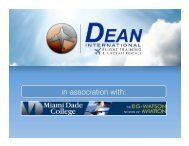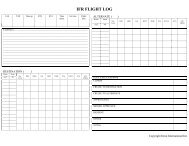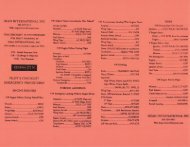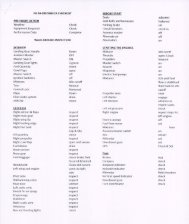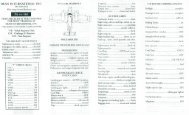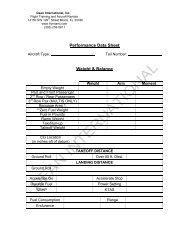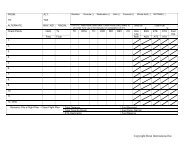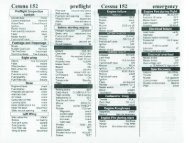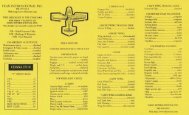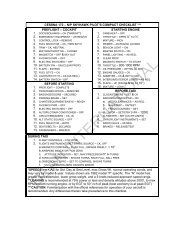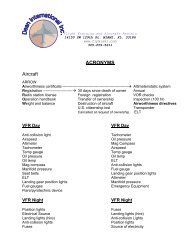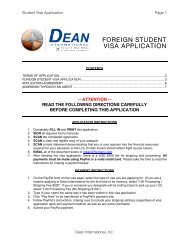Dean Flight Review
Dean Flight Review
Dean Flight Review
You also want an ePaper? Increase the reach of your titles
YUMPU automatically turns print PDFs into web optimized ePapers that Google loves.
FLIGHT REVIEW<strong>Flight</strong> Training and AircraftRentals14150 SW 129th St. MIAMI, FL. 33186www.flymiami.com305-259-5611All Private Pilots should answer the general questions.1. What personal documents and endorsements are you required to have before youfly?2. What are your private pilot limitations regarding carriage of passengers or cargoand flying for compensation or hire?3. Explain private pilot limitations concerning visibility and flight above clouds.4. Who has final authority and responsibility for the operations of the aircraft whencarrying passengers?5. Discuss what preflight action concerning the airport and aircraft performance isspecified in the regulations for a local flight.6. True or false. During engine run up you cause rocks, debris and propeller blast tobe directed toward another aircraft or person, could this be considered careless orreckless operations in an aircraft?7. You may not fly as pilot in command of civil aircraft within hoursafter consumption of any alcoholic beverage, or while you have % byweight or more alcohol in your blood.Pilot’s Name:Date:
8. What are the general requirements pertaining to the use of safety belts andshoulder harnesses?9. What is the minimum fuel reserve for day VFR, and night VFR flight, an on whatcruise speed is the fuel reserve based?10. A transponder with Mode C is required at all times in all airspace at and abovefeet MSL, excluding that airspace at and below .11. What aircraft certificates and documents must be on board?A.R.R.O.W.12. No person may operate an aircraft so close to another aircraft as to create a(n)13. Who has the right-of-way when two aircraft are on final approach to land at thesame time?14. What action do you need to take if you are overtaking another aircraft and whichaircraft has the right-of-way? What should you do if you are flying a head oncollision course with another aircraft? If another single-engine aircraft isconverging from the right, who has the right-of-way?15. Except when necessary for takeoffs and landing, what are the minimum safealtitudes when flying over congested and other than congested areas?16. If an altimeter setting is not available at an airport, what setting should you usebefore departing on a local flight?
17. When practicing steep turns, stalls, and maneuvering during slow flight, the entryaltitude must allow a recover to be completed not lower thanfeet AGL.18. When is a go-around appropriate? Explain go-around procedures.19. What general steps should you follow after an engine failure in flight?AIRCRAFT QUESTIONS1. List the minimums equipment and instruments that must be working properly inyour aircraft for day VFR flight.2. Fill in the V-speed definitions and the corresponding speed for your trainingairplane.V SOV S1V XV YV FEV AV NOV NEDEFINITION3. What is the best glide speed for your training airplane?SPEED4. What is the maximum allowable flap setting for takeoff in your aircraft?5. The total usable fuel capacity for your aircraft is gallons. On astandard day (sea level temperature, 59°F altimeter 29.92 in. Hg), the fuelconsumption rate during normal (approximately 75% power) cruise isgallons per hour.
6. What grade(s) of fuel can be safely used in your aircraft? What are the colors ofthe recommended fuels? What happens to the color of the fuel if two grades aremixed?7. The maximum oil capacity of your aircraft is oil capacity to begin a flight isquarts, and the minimum oil capacity to begin a flight is quarts.8. When do you use carburetor heat? What are the indications of carburetor icing?9. What is the takeoff and landing distance over a 50 foot obstacle for your aircraftat your airport? Assume maximum certificate takeoff weight, 80°F, winds calm,and an altimeter setting of 29.92.AIRPORT AND LOCAL AIRSPACE QUESTIONS1. What are the traffic patterns for each runway at your airport? What is the MSLaltitude for the traffic pattern?2. How do you enter and exit the traffic pattern at your airport? What, if any, radiocommunications are required?3. What radio calls are recommended in the traffic pattern at an uncontrolled airport?What radio calls are required at your airport?4. What is the standard direction of turns in the traffic pattern? Give an example of avisual display indication a nonstandard traffic pattern.
5. How can you determine if a runway is closed?6. What are the typical dimensions of Class D airspace and what requirements(s)must be met prior to entry?7. Can you practice ground reference maneuvers when you are within Class Dairspace? Explain.8. If you receive ATC instructions that you feel may compromise safety or willcause you to violate an FAR, what should you do?9. What is the meaning of each of the following ATC light signals?IN FLIGHTSteady green -Flashing green -Steady red -Flashing red -Alternating red & green -ON THE GROUNDSteady green -Flashing green -Steady red -Flashing red -Alternating red & green -Flashing white -10. As a private pilot can you fly into a Class B airport? What are the equipmentrequirements:11. Explain the general transponder equipment and use requirement(s) whenoperating within or near Class B airspace.
12. Describe Class B airspace boundaries, and how they apply to an airport withinthat airspace. Explain how you can use navigations equipment and/or groundreference points to identify the Class B boundaries. (Draw a diagram ifnecessary.)13. You have called ATC just prior to entering Class B airspace, and the controllertells you to, “Squawk 2466 and ident.” are you now allowed to enter Class Bairspace without any further instructions? Explain.14. On a sectional chart, what does a dashed magenta line around an airport indicate?15. Explain the minimum visibility and ceiling requirements for VFR flight in ClassD airspace.16. Can a private pilot or recreational pilot request a special VFR clearance in ClassD airspace when visibility is less than three miles? Explain your answer.GENERAL QUESTIONS1. 1. A BFR must contain ground instructionflight instruction.2. The ground portion of the BFR Must contain a comprehensive review or Part3. The flight portion of the BFR must contain these maneuvers:4. What flights must be logged in a logbook?
5. In order to carry passengers, you must have made landings in thecategory and class within the previousdays.6. What drugs cannot be taken before a flight?7. A parachute is necessary, if a pilot is carrying a passenger, if a bank angle ofdegrees or a nose up or down angle of degrees for anyintentional maneuver is exceeded.8. Where is a transponder (with Mode C) necessary?A.B.C.D.E.9. Oxygen is required above feet regardless of the time flown at thataltitude.10. What three flight instruments are required for this flight?11. An ELT is required if a training flight goes beyond miles fromyour departure point and the aircraft is equipped to carry more than one person.12. When aircraft are approaching head on, each aircraft shall alter their course to the.13. Two-way radio communications are necessary within Class(es)airspace.14. The standard pattern at an airport without a control tower and no visual patternmarkings is-hand turns.15. Clearance from ATC is necessary to penetrate Class(es)airspace.16. You may not operate in or areas withoutpermission of the controlling agency.’17. You may not operate in Class A airspace under flight rules.
18. Basic VFR weather minimums in controlled airspace below 10,000 feet aremiles visibility and below, above, andhorizontally from clouds.19. VFR minimums in Class G airspace, under 10,000 feet, daytime, aremile(s) visibility andof clouds.20. Under Special VFR, daytime, you may operate with visibility at leastmiles andof clouds.21. When is an instrument rating required to operate under Special VFR?22. When operating below 18,000 feet MSL and above 3,000 AGL, you should cruiseat thousands plus 500 feet on a mag. course of 360 through 179degrees, and thousands plus 500 feet on a mag. course of 180 through359 degrees.23. The maximum allowable gross weight for this aircraft ispounds.24. Our takeoff gross weight is pounds.25. Our center of gravity is and is within limits. (show work)26. Our fuel minimum for this flight is gallons.27. Our stall speed in a clean configuration is mph/kts (circle one).



